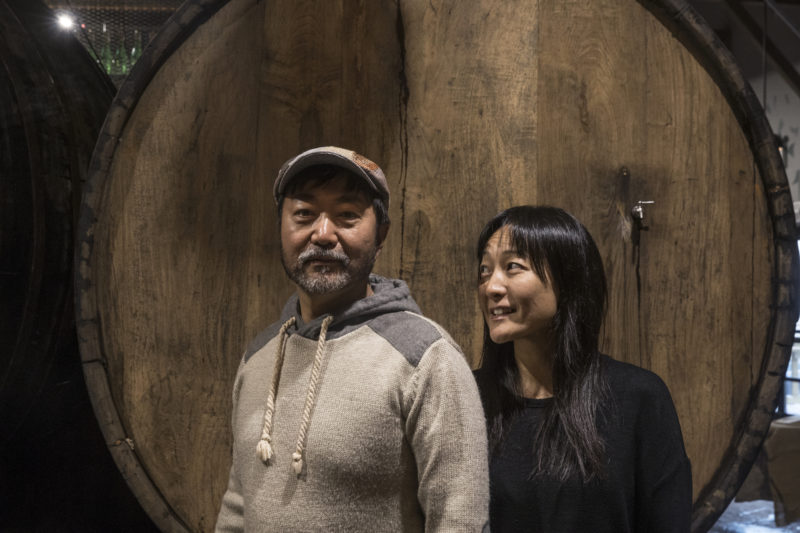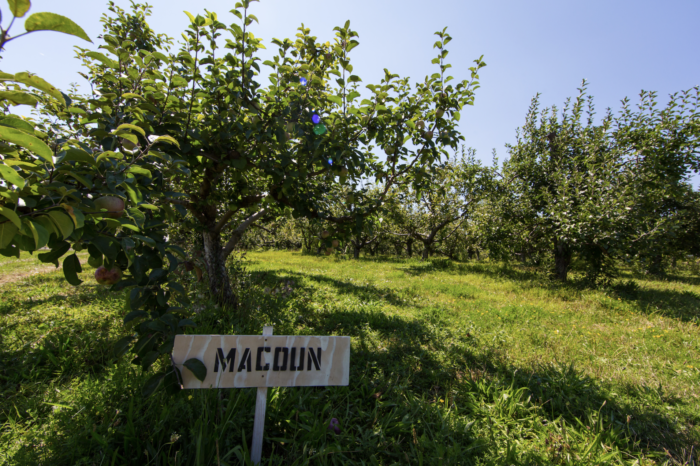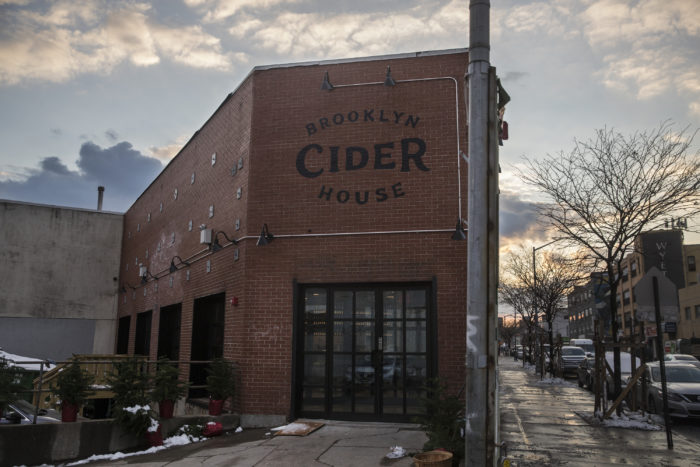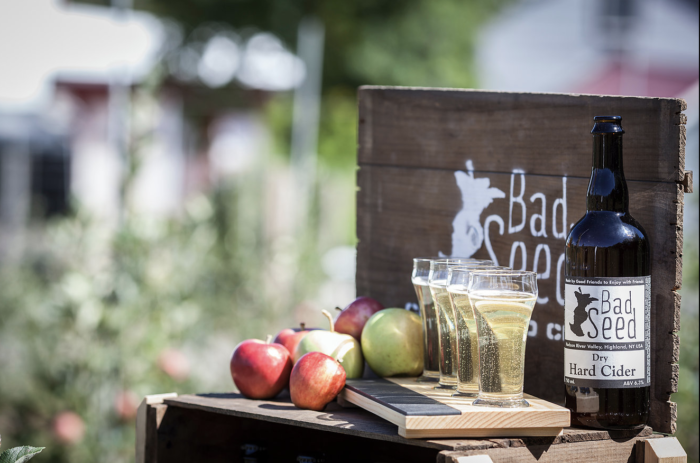Hard Cider, Enjoying a Boom, Bubbles up in Brooklyn
A new Bushwick cidery and restaurant reflects a joyful obsession with Basque cuisine
Peter Yi, chief cider maker at the new Brooklyn Cider House, with his sister Susan, a partner in running their upstate apple orchard (Photo by Victor J. Blue/The New York Times/Redux)
If you walk past 1100 Flushing Ave. in Bushwick, you’ll spot a sign that reads “Ugly Apples Taste Better.” What might initially sound like enigmatic graffiti is, however, the motto of Brooklyn Cider House, the borough’s first cidery complete with a fermenting house, bar and restaurant. That slogan touted by Chief Cider Maker Peter Yi and his partners means they pick the apples for their brew based on flavor, not appearance. Those big, showy supermarket apples need not apply.
Hard cider is the latest borough-made beverage on tap in Brooklyn, which already has several liquor distilleries and at least 20 breweries. In fact, hard cider is booming nationwide, especially in New York State, which has 35 cider-making mills. Cider is a natural match for New York, since it’s the country’s No. 2 producer of apples, right behind Washington State.
As cider makers hone their expertise, they’re coming up with refined and varied products, much as vintners and brewmasters do. Brooklyn Cider House, which opened this week, currently produces five award-winning ciders of its own, along with other apple-fermented beverages from around the world. Kinda Dry is a slow-fermented cider, reminiscent of a “crisp fall day,” says Yi. Half Sour contains aromas of honey, wild flowers, citrus and pickled pear. Bone Dry is a fizzy, traditional type, while the non-carbonated Still Bone Dry is “astonishingly close to white wine.”

The new Bushwick cidery grows its apples on 50 acres upstate, near New Paltz (Photo courtesy of Brooklyn Cider House)
Yi’s latest creation, called Raw, is his quintessential interpretation of Basque cider, inspired by the variety he drank in that region of Spain on a trip that inspired the whole enterprise. “The cider had such an impact on me that all I could do was think about this beverage that was just so food-friendly,” says the effusive Yi. “Raw was the reason why I got into the cider business. Call it an inspirational cider.”
In the spring of 2014, Yi, a partner in a Manhattan wine shop, was in Basque country to appraise some Rioja when he became mesmerized by the local food culture. “In the Basque region, people take food very seriously. I’m nuts about food and I almost don’t fit in other places, but when I’m there, I’m normal. Things that I do, everyone does!” He became particularly enthusiastic about the local cider, a variety that is low in alcohol and lighter than wine and beer. “The thing that really struck me about the ciders in the Basque region is that you can drink a lot of it and not feel terrible in the morning.”
He decided to master the art of cider making. But he would need a big, carefully cultivated supply of apples. In 2015, he and his partners (his sister Susan, an educator; and their friend Lindsey Storm, a former corporate-bond trader) bought Twin Star Orchards near New Paltz, where they now have 50 acres of apples in production.
At the orchard they planted nearly 8,000 baby trees to grow rare, hard-cider varieties and disease-resistant heirloom types. Among Yi’s favorites are Northern Spy, Rhode Island Greening, Golden Delicious, Manchurian Crabapple and Ellis Bitter. None are grown for their cuteness on a store shelf. Yi is growing for taste: a balance of bitter, tart and sweet.

After looking for a location in several Brooklyn neighborhoods, the partners settled on this roomy brick facility on Flushing Avenue (Photo by Victor J. Blue/The New York Times/Redux)
Farm-based beverage makers like Yi’s have proliferated in New York because of the state’s concerted effort to boost the industry with relaxed regulation and financial incentives. As a result, the number of craft-beverage makers has reached 1,000, up from 300 in 2011. A major factor is the expansion of “farm licenses,” allowing growers to sell their products directly to consumers.
Brooklyn Cider House has a thriving tasting room upstate, but being Brooklynites themselves–Peter and Susan Yi grew up in the Kensington neighborhood–they wanted to open a space in their hometown. After searching for spots in Red Hook, Gowanus and other neighborhoods, the cider makers and a team of investors found a spacious (15,000 sq. ft.) facility that would accommodate a tasting room and a restaurant, along with the fermentation tanks to make cider on premises from apple juice trucked in from the upstate farm.
“We were particularly interested in Bushwick because it still feels like a real Brooklyn neighborhood with working-class families and big pockets of immigrant American communities. Peter and I can identify with that,” said Susan Yi, who feels a connection with Bushwick’s history as a brewing center and now a neighborhood bustling with entrepreneurship and art. “We’re surrounded by people who are creative, passionate, and willing to take risks.”

Bad Seed Cider Co. grows its apples in upstate Highland and operates a taproom in Crown Heights (Photo courtesy of Bad Seed)
They have fellow cider-makers in the borough as well. A few years ago, Cobble Hill resident Jahil Maplestone was disappointed with the lack of cider available on tap or at the local bodega, so he decided to start his brand Descendant Cider from a spare room of his apartment. His ciders blend traditional recipes with innovative ingredients such as rooibos or hibiscus flower. “Every year the number of producers grows and with that grows the awareness in the community,” says Maplestone. “Cider is here to stay and it’s only getting better.”
Bad Seed Cider Co., with orchards in upstate Highland, recently opened a cider taproom in Crown Heights with 20 taps rotating among different varieties. Co-owner Bram Kincheloe, who is also a musician and writer, enthusiastically touts the beverage’s merits. “It is a glorious alternative to either beer or wine, in addition to being gluten free, and [in] the vast majority of our ciders, sugar free,” he says. “You can drink more cider than wine, by nature of the fact that cider has a lower [alcohol by volume], and you can drink more cider than beer in the sense that it isn’t heavy like a strong IPA or stout.”
What’s more, cider goes well with food. Brooklyn Cider House is offering five-course tasting menus (traditional Basque for $37; vegetarian for $32), as well as bar snacks. “It works with salads all the way up to red meat and everything in between–grilled vegetables, eggs, chicken, rice, noodles and more,” says Yi. “The only thing that might not pair with it is Captain Crunch cereal.”
An earlier version of this story referred to Peter Yi as “co-owner” of Brooklyn Cider House. In fact, his title is “chief cider maker.”










